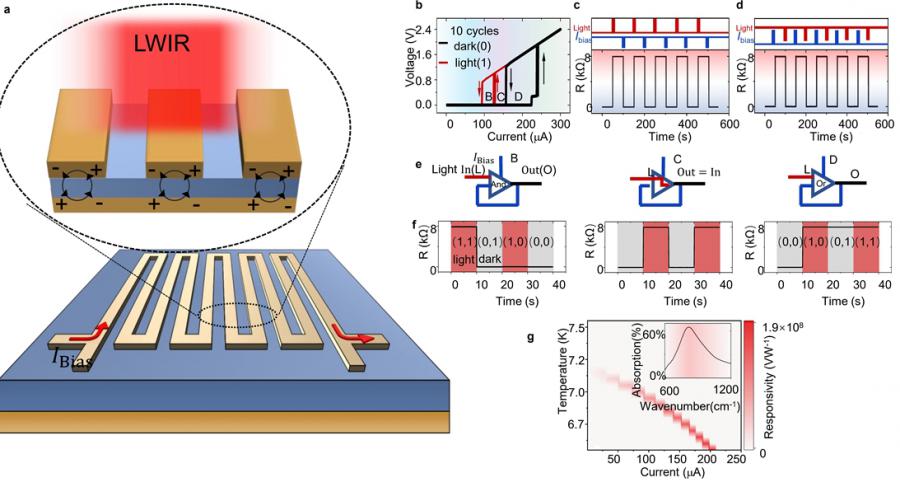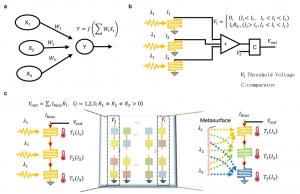
Reconfigurable memlogic LWIR sensing with superconductors
USA, August 30, 2024 /EINPresswire.com/ -- Superconducting memlogic sensors merge in-cell logic and memory, advancing machine vision beyond traditional computing. These sensors utilize the quantum-sensitive and broad-spectrum capabilities of superconductors. We introduce a long-wave infrared sensor using superconductor-normal phase bistability, enabling deterministic, persistent switching. This device enhances encrypted communications and features high infrared sensitivity (12.2 μm) through metamaterial design. This innovation could surpass biological retinas in sensitivity and wavelength, integrating advanced perception into quantum machines.
With the rapid development of Artificial Intelligence (AI) and the Internet of Things (IoT), the number of optical sensors has significantly increased. These traditional sensors generate vast amounts of unstructured and redundant data, leading to unnecessary energy consumption and information latency during data transmission to storage and computing units. In contrast, the human visual system has an efficient and low-power parallel processing capability, allowing simultaneous perception and processing of images. To address the issues associated with the von Neumann architecture, researchers have developed memory-computing systems based on various materials like 2D materials, phase-change materials, and ferroelectric materials. However, these systems, based on such materials, often suffer from weak light response and large band gaps, requiring high-power light sources for optical computing, with few reported capable of in-sensor-computing at long-wave infrared. In the infrared domain, AI perception plays a critical role in various fields, including but not limited to thermal imaging, surveillance, industrial inspection, gas detection, medical thermal imaging, defense, and space exploration.
In a new paper (doi: https://doi.org/10.1038/s41377-024-01424-2 ) published in Light Science & Applications, a team of scientists, led by Professor Zhenghua An from Fudan University, Yanru Song from ShanghaiTech University and co-workers have developed a superconducting memlogic sensor that integrates the capabilities of infrared sensitivity, memory retention, and reconfigurable logic computing, all-in-one infrared memlogic sensory. They demonstrate the simultaneous four controls of this superconducting device including optical/electrical biases, and optical/electrical pulses allow different encoding logic with increasing functional complexity. With these reconfigurable operations, they show the infrared remote encrypted communication at a single device level. Given the prevalence of bistable effects, extensive wavelength coverage, and high photo-sensitivity in superconductors, their memlogic sensing concept, utilizing superconducting phase transitions, shows potential for versatile applications across a wide electromagnetic spectrum and down to quantum-levels in various fields such as machine perception, remote sensing, secure communication, and space detection. These scientists summarize the operational principle of their sensor:
“Distinctive from existing superconducting sensors (like SNSPDs and TESs), our device works in the bistable region of the hysteretic superconductor-normal phase transition. This hysteretic IV is often considered as a hindrance to most of the superconducting devices’ performance although they can be indeed utilized as switches or memories. By contrast, here we take the advantages of the hysteresis behavior and show its favorable applications in memlogic optical sensing.”
“To overcome the well-known low system detection efficiency of superconducting detection in this long-wave infrared region, we adopt a metamaterial perfect absorber concept which consists of a resonant plasmonic cavity, with tri-layer structure of Nb-Si-Nb.” they added.
“This sensor can be integrated on a large scale and requires only two electrodes for readout circuit, which is crucial for cryogenic application. Future prospects for this technology include applications in telecommunications, superconducting computing, AI-driven image processing, and intelligent on-chip spectrometers.” the scientists forecast.
DOI
10.1038/s41377-024-01424-2
Original Source URL
https://doi.org/10.1038/s41377-024-01424-2
Funding information
This work was supported by National Natural Science Foundation of China (NSFC) (12027805, 11991060), the Shanghai Science and Technology Committee (18JC1420400, 20JC1414700 and 20DZ1100604), Shanghai Pujiang Program (No. 20PJ1410900)
Lucy Wang
BioDesign Research
email us here
Distribution channels: Science, Technology
Legal Disclaimer:
EIN Presswire provides this news content "as is" without warranty of any kind. We do not accept any responsibility or liability for the accuracy, content, images, videos, licenses, completeness, legality, or reliability of the information contained in this article. If you have any complaints or copyright issues related to this article, kindly contact the author above.
Submit your press release


